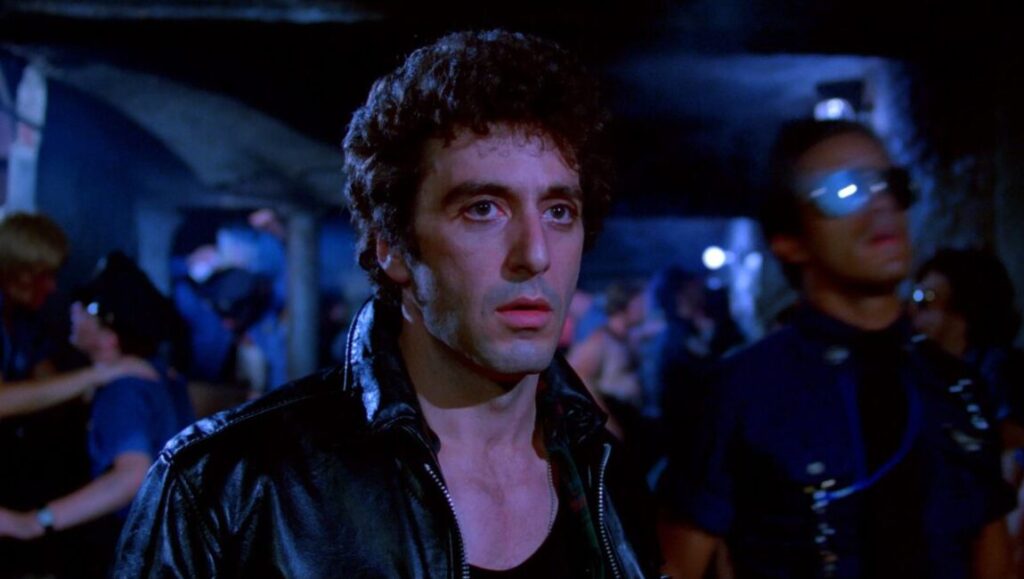A languid watercraft cruising the currents of the Hudson River. “Captain! Something off the port bow!” A rotten human arm floating in the distance. It was February 8th, 1980 — a new decade — that saw the release of William Friedkin’s Cruising. Ever the tinkerer, Friedkin has since released a director’s cut of his film, which begins, instead, with a little prelude: two high-contrast, grainy, black-and-white shots, one of the film’s lead actor, Al Pacino, observing a crowd outside the Wolf’s Den club, and the other of Pacino alone, awaiting a rendez-vous, in the silence of the night. These shots come paired with some very to-the-point title cards: “AL PACINO” and “WILLIAM FRIEDKIN’S CRUISING.” The original cut’s opening offers few tells for what lies ahead, but Friedkin’s revised version lays out at least a glimpse of the initiation of the story (which is set largely in New York City’s meatpacking district), as well as a hint of its denouement; it offers a taste of the story’s various radical narrative jumps and games, as well. We don’t even formally meet Pacino’s Officer Steve Burns until about 16 minutes into either cut of Cruising, though we witness a prominent showing of the types of people and locales that he will face and that he’ll frequent over the course of the film. We even witness a killing beforehand — and it’s no accident that Burns bears resemblance to both the killer and to his first victim.
Friedkin doesn’t stop there – the murderer is played by various actors, several of whom also play the victims, in a game of visual disorientation which keeps us fighting to stay sharp while in a state of constant delirium; we’re thrown from hole-in-the-wall club to grease-on-the-wall club, from one late night to the next, even later night.
Cruising finds Friedkin playing with doubles, lookalikes, and doppelgangers; each subsequent pairing of killer and victim parades, and rearranges, actors with slightly-curly black hair and a slightly dark skin complexion. But Friedkin doesn’t stop there – the murderer is played by various actors, several of whom also play the victims, in a game of visual disorientation which keeps us fighting to stay sharp while in a state of constant delirium; we’re thrown from hole-in-the-wall club to grease-on-the-wall club, from one late night to the next, even later night. The first time we see Burns, he confuses his own captain’s name: “Captain Edelstein?” he asks, and is then corrected from beyond the frame. “Edelson.” The former name translates, from German, to ‘gemstone,’ which might be construed as a queer-culture adjacent reference, while the latter name is one “h” removed from Edel Sohn, the German phrase for “noble son” – an upholding of heteronormativity? (Edelson is also played by Paul Sorvino, who acted opposite Pacino nearly a decade earlier in Jerry Schatzberg’s The Panic in Needle Park, a possible hint toward Friedkin’s casting inspirations.) Burns’s confusion – and thus, our own – extends from mixed-up suspects and case clues to his own ambiguous sexuality and personal relationships; something weird is happening in Burns’s neighbors’ apartment, and though we never see him explicitly engaged in homosexual behavior while undercover, he’s distant during sex with his girlfriend, Nancy (Karen Allen). His eyes tell tales of those incidents we’re not privy to during long nights spent cruising. In the end, the couple comes together, despite their tensions; he wants to tell her everything. She dons his outfit in the living room — decked out in garb which places her in the lineage of the film’s various killer doppelgangers — while Burns stares at himself in the mirror, tears ready to fall. We see a tugboat on the Hudson. With a bullwhip crack of a snare hit, Willy DeVille’s “It’s So Easy” wrangles in the closing credits. So began the Eighties.
Part of Kicking the Canon – The Film Canon.


Comments are closed.